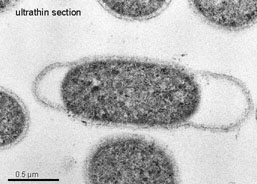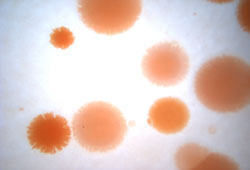Characteristics:
- no membrane-covered nuclei and organelles
- mostly unicellular
- reproduce asexually by binary fission
- produce food through photosynthesis but use a wider variety of substances as raw materials than eukaryotes
- tiny organisms
- a cell wall, usually surrounded by a layer of slime, encloses the cell
-simplest microorganisms, single-celled or noncellular spherical or spiral or rod-shaped organisms lacking chlorophyll that produced by fission
Classification according to shape:
1.coccus-spherical

2.bacillus-rodlike

3.spirillus-spiral

Functions of Monerans:
- Sewage disposal
- Production of cheese and vinegar
- Used in tanning leather and curing meat
- production of anibiotics like neomycin
- Biological control of harmful insects
1.cell wall-peptidoglycan
2.flagellum-for movement
3.pili-for attachment
4.mode of reproduction
Asexual:Binary Fission
Sexual:Conjugation, Transduction and Transformation
Cyanobacteria
-predominantly photosynthetic prokaryotic organisms containing blue pigment in addition to chlorophyll
-occur singly or in colonies in diverse habitats that can form filaments that they split up in 2 or break into fragments for reproduction
-examples:Anacbaena, oscillatoria, nostoc
-can carry out photosynthesis and absorb food from surroundings

Two Prokaryotic Kingdoms:
Archaebacteria
Kingdom of prokaryotes more like eukaryotic cells than eubacteria.
Major Groups of Archaebacteria:
Methanogens(methane maker)
- live at swamps, sewage, stockyards, animal guts and other oxygen free habitats
- their anaerobic pathway ends in methane
- they release 2 billion tons of methane from termite guts, ruminant guts, wetlands, rice paddies and landfills
- this tremendous quantities of this by-product influence carbon dioxide levels in the atmosphere and the global carbon dioxide cycle

Extreme halophiles(salt lovers)
- live in very salty water, as in brackish ponds and salt lakes, and near hydrotherml vents
- they spoil salted fish, animal hides, and commercial sea salt
- most of them make ATP by aerobic pathways
- some also switch to a photosynthetic pathway when oxygen is low
Extreme thermophiles(heat lovers)
- live in highly acidic soils, hot springs, even coal mine wastes
- some start the food webs at hydrothermal vents, where water reaches 110 degrees Celsius
- they get electrons from hydrogen sulfide
- they are cited as evidence that life originated deep in the oceans

Chemosynthesizers
Instead of using the Sun's energy, chemosynthesizers absorb compounds that contain sulfur, iron and nitrogen, and get their energy through a process called oxidation. They use the energy to change carbon dioxide into organic food molecules, which support a whole community of other organisms. Chemosynthesizers can live in harsh environments where no other producer could survive, like the hot sulfur vents on the ocean floor.

Eubacteria
Unlike archaebacteria, they have fatty acids in their plasma membrane. In most cases their cell wall incorporates peptidoglycan.
Modes of Nutrition:
Photoautotrophs

- cyanobacteria, or blue-green algae, are common oxygen releasing, photosynthetic types
- you may see them at ponds and lakes where mucus-sheathed chains of cells form slimy mats in nutrient enriched water
- Anabaena and other types can convert nitrogen to ammonia for biosynthesis
- if nitrogen compounds dwindle, modified cells call heterocysts synthesize a nirogen fixing enzyme. they produce and share nitrogen compounds with other cells in the chains and get carbohydrates in return.
- anaerobic photosynthesizers get electrons from hydrogen sulfide or hydrogen gas, not water. They may resemble anaerobic bacteria in which the cyclicathway of photosynthesis is involved.
Chemoautotrophs

- they have mighty roles in the cycling of nitrogen and other nutrients
- many have roles as decomposers and as human helpers
- Lactobacillus is used to help make pickles, buttermilk and yoghurt
- Actinomycetes to make antibiotics
- E. coli in our gut produces Vitamin K and compounds that help us digest fat. It also helps newborns digest milk, and it prevents many food-borne pathogens from colonizing the human gut
- sugarcane and corn rely on the nirogen-fixing spirochete Azospirillum. They take up some nitrogen fixed by this symbiont and give some sugars to it.
Gram Positive Bacteria
-the bacteria's cell wall is mad eup of a protein-sugar complex that takes on a purple color during the Gram Staining .
Gram Negative Bacteria
-the gram negative bacteriahas an extra layer of lipid on the outside of lipid on the outside of the cell wall and appear pink during the Gram Staining
Gram Staining- a test on cell walls developed by Hans Christian Gram

6 comments:
Its use for science students
its really informative
very nicely presented, good work! very useful for beginners.
hi this is vry useful fr us to get gud n benificial knowledge fr students thanx
hi this is vry useful fr us to get gud n benificial knowledge fr students thanx
hi this is vry useful fr us to get gud n benificial knowledge fr students thanx
Post a Comment